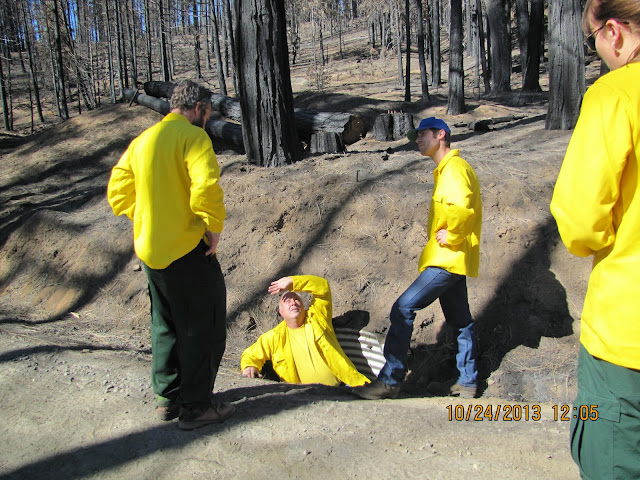 |
| The Burned Area Emergency Response (BAER) implementation team continues to assess needs and implement emergency stabilization measures. |
- Improving road drainage and storm proofing roads at risk of failure from increased flooding.
- Stabilizing and repairing trails.
- Monitoring for and treating invasive weeds.
- Providing safety emergency signs.
- Mulching and chipping to protect fragile soils.
The National Weather Service has been working with the the CA-NV River Forecast Center and the United States Geological Survey to develop precipitation thresholds that will likely trigger debris flows rock slides ash movement and flash floods on the Rim Fire burn scar.
These are the initial values we will be utilizing going into this winter.
There are three phases of rehabilitation following wildfires on federal lands:- .2" in 15 minutes
- .3" in 30 minutes
- .5" in 1 hour
- .9" in 3 hours
- 1.4" in 6 hours
- Fire Suppression Repair
- Emergency Stabilization-Burned Area Emergency Response (BAER)
- Long-Term Recovery and Restoration
Emergency Stabilization-Burned Area Emergency Response (BAER) is a rapid assessment of burned watersheds by a BAER team to identify imminent post-wildfire threats to human life and safety property and critical natural or cultural resources on National Forest System lands and take immediate actions to implement emergency stabilization measures before the first major storms.
Long-Term Recovery and Restoration utilizes non-emergency actions to improve fire-damaged lands that are unlikely to recover naturally and to repair or replace facilities damaged by the fire that are not critical to life and safety. This phase may include restoring burned habitat reforestation planting replacing burned fences interpreting cultural sites treating noxious weed infestations and installing interpretive signs.
For public safety the Rim Fire closure is still in effect.
Please abide by the closure signs. Crews and equipment are working in the area creating a hazardous situation. Burned trees continue to fall. For more information select the closure tab above.
Thank you for very usefull information.. emergency evacuation plans
ReplyDelete